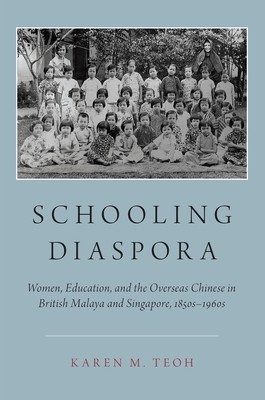
- We will send in 10–14 business days.
- Author: Karen M Teoh
- Publisher: Oxford University Press, USA
- ISBN-10: 0197533345
- ISBN-13: 9780197533345
- Format: 15.5 x 23.1 x 1.5 cm, minkšti viršeliai
- Language: English
- SAVE -10% with code: EXTRA
Reviews
Description
Education has long been a cornerstone of Chinese culture. Traditional Chinese norms have also held that the less education and exposure to influence from outside the home a girl had, the more likely she would be to remain true to conventional domestic values and to remain morally upright. In the mid-nineteenth century, overseas Chinese communities encountered a new perspective via Western European and American missionary schools. Formal education could be not just helpful but integral to preserving female virtue and had the added benefit of elevating the socio-cultural status of the overseas Chinese. As a result, increasing numbers of girls began to attend school. Within a few decades, other groups who sponsored female education-local Chinese community leaders, mainland Chinese reformists, the British colonial government-were offering a competing approach: education for the sake of modernization. These diverse and sometimes divergent priorities preoccupied educators, parents,
politicians, and, of course, the girls and women who attended these institutions.
desired ideals. Chinese women in diaspora found that failing to conform to any number of state priorities could lead to social disapproval, marginalization, or even outright deportation. Overseas Chinese communities were mindful of these perils, and their responses were as myriad as their modes of identity construction and adaptation. They grappled with questions of how this project might support Chinese nationalism, absorb the best of British colonial influence, and strengthen their image as a stable, modern, and desirable population in their countries of settlement. Bridging Chinese and Southeast Asian history, British imperialism, gender, and the history of education, Schooling Diaspora shows how these diasporic women contributed to the development of a new figure: the educated transnational Chinese woman.
EXTRA 10 % discount with code: EXTRA
The promotion ends in 21d.06:22:03
The discount code is valid when purchasing from 10 €. Discounts do not stack.
- Author: Karen M Teoh
- Publisher: Oxford University Press, USA
- ISBN-10: 0197533345
- ISBN-13: 9780197533345
- Format: 15.5 x 23.1 x 1.5 cm, minkšti viršeliai
- Language: English English
Education has long been a cornerstone of Chinese culture. Traditional Chinese norms have also held that the less education and exposure to influence from outside the home a girl had, the more likely she would be to remain true to conventional domestic values and to remain morally upright. In the mid-nineteenth century, overseas Chinese communities encountered a new perspective via Western European and American missionary schools. Formal education could be not just helpful but integral to preserving female virtue and had the added benefit of elevating the socio-cultural status of the overseas Chinese. As a result, increasing numbers of girls began to attend school. Within a few decades, other groups who sponsored female education-local Chinese community leaders, mainland Chinese reformists, the British colonial government-were offering a competing approach: education for the sake of modernization. These diverse and sometimes divergent priorities preoccupied educators, parents,
politicians, and, of course, the girls and women who attended these institutions.
desired ideals. Chinese women in diaspora found that failing to conform to any number of state priorities could lead to social disapproval, marginalization, or even outright deportation. Overseas Chinese communities were mindful of these perils, and their responses were as myriad as their modes of identity construction and adaptation. They grappled with questions of how this project might support Chinese nationalism, absorb the best of British colonial influence, and strengthen their image as a stable, modern, and desirable population in their countries of settlement. Bridging Chinese and Southeast Asian history, British imperialism, gender, and the history of education, Schooling Diaspora shows how these diasporic women contributed to the development of a new figure: the educated transnational Chinese woman.


Reviews